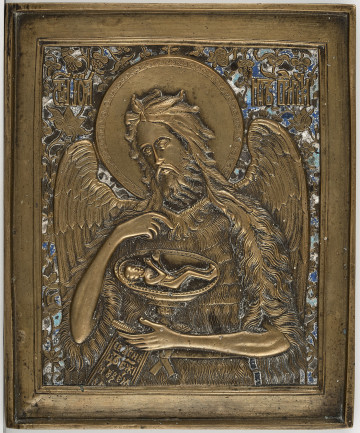
St. John the Baptist
20th century
Castle Museum in Łańcut
Part of the collection: Icons
Kazan Icon of the Mother of God Hodegetria Hermogen, the clergyman holding the office of Moscow Patriarch in the years 1606-1612, contributed to the spread of the cult of the Kazan Hodegetria icon, which miraculously appeared in 1579 (see S.12770MŁ; S.12773MŁ). For the Russian Tsardom, it was a time of self-proclaimed rulers and frequent changes to the throne. After Vasili IV Shuisky was dethroned in 1610, the potential successor to the tsar's crown was a Polish prince and later king, Władysław IV Vasa. The presence of the Polish army in the war- and famine-ravaged Moscow did not help to calm the situation. Patriarch Hermogen, who could not agree to cede the throne to a Catholic monarch, did not live to see the Russian armies, led by Dmitry Pozharsky and carrying the Kazan Mother of God icon, capture Moscow. A procession with Moscow's Kazan Hodegetria image, led by the Greek archbishop Arsenius, came out to meet them. Both icons of the Mother of God - the copy of the Kazan original and the copy from Moscow - met on the 22nd of October (November 4th in the Julian calendar) 1612. Since then, the Kazan Hodegetria has been called the intercessor of Rus, and it has proven the aptness of this title more than once in the history of Russia. The depiction was repeatedly reproduced in numerous copies, starting from the ones famous for miracles, meticulously decorated with rizas (robes with jewels), and ending with the small household icons, frequently in gilded brass coverings, like the displayed S.12778MŁ. Among the zealous worshippers of the Kazan Mother of God were the members of the Romanov dynasty, which ascended to the tsarist throne in 1613 and lasted until the 1917 revolution, as described under S.12816MŁ. Teresa Bagińska-Żurawska https://orcid.org/0000-0002-9243-3967
Other names
Kazan Mother of God
Dimensions
height: 17.5 cm, width: 14 cm
Object type
Icons
Technique
gilding, tempera, metalloplastics
Material
silver, brass, tempera, wood
Origin / acquisition method
decyzja administracyjna
Creation time / dating
Creation / finding place
Owner
Castle Museum in Łańcut
Identification number
Location / status

20th century
Castle Museum in Łańcut

19th (?) century
Castle Museum in Łańcut

1800 — 1850
Castle Museum in Łańcut
DISCOVER this TOPIC
Castle Museum in Łańcut
DISCOVER this PATH
Educational path